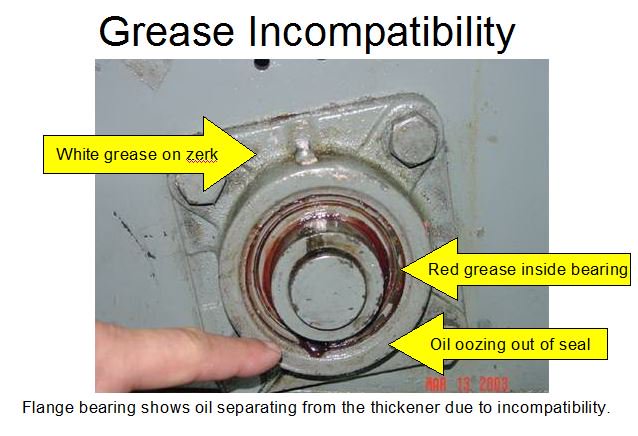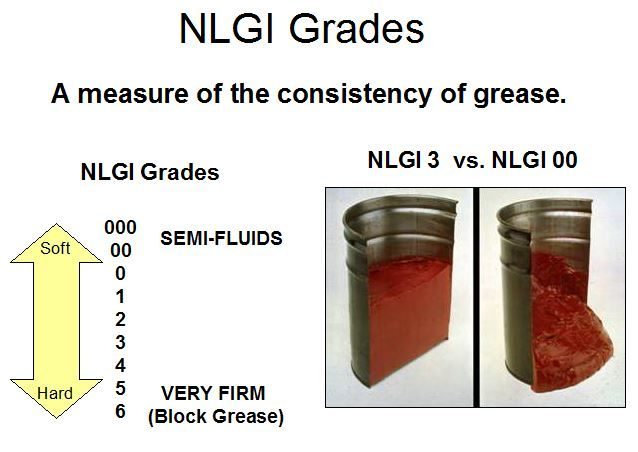Multipurpose grease can cover many applications making it desirable for reducing inventories and associated costs, and simplifying a lubrication program. In general, most multipurpose greases are lithium thickened and have Antiwear (AW) and/or Extreme Pressure (EP) additives and base oils with viscosities ranging from SAE 30 to SAE 50.
But multipurpose greases cannot handle all applications in the typical industrial facility. To understand grease, we must look at grease make-up. Grease is essentially made up of three things; base stock or stocks, a thickener and additives.
When considering grease, general factors to consider include;
- Grease Thickener Type
- Base Fluid Type
- Base Fluid Viscosity
- Additive Requirements
- NLGI Grade
Also consider the environmental conditions of the application. Ambient temperature ranges and location of the application are necessary to assess the conditions in which the grease must perform. Wet environments and dusty conditions require more frequent regreasing to help keep these contaminates out of the components. Also consider the operating temperature of the application and relubrication logistics to determine the best product to use and best method for applying the grease. Remote or difficult to access locations make the case for automatic lubricators. From a base oil type and viscosity standpoint, extreme temperature ranges must be factored into the decision on which grease to choose.
Grease thickeners are vast in number and some have unique properties and benefits. Some thickener types can add performance characteristics to the grease. For example, water resistance can be improved when aluminum complex or calcium complex thickeners are used. There is a heat advantage that some thickeners have over others. Thickener Compatibility is of major concern. There are Thickener Compatibility Charts available to consider, but the best approach is to consult with your supplier to see if they have run compatibility tests against different thickener types. If not, grease compatibility testing can be run for a few hundred dollars to ensure against compatibility issues.
Base stocks used in greases are typically mineral oil, synthetic blends or full synthetic stocks. Polyalphaolefin (PAO) synthetic oils are used frequently, as these are compatible with mineral base oils. Other synthetic fluids used in grease manufacture include esters, silicone fluids, Perfluoropolyethers, and other synthetics and synthetic blends. Again, compatibility of
the base stock(s) used in different greases isn’t assured. Check the grease manufactures data to see if it states the base oil type. If there is doubt, contact the supplier for more information on the type of base fluid used in the candidate grease. Check it for compatibility with the base fluid used in the grease that is currently in service. Remember that the Viscosity of the base fluid used in the grease should be matched as close as possible to the requirements for Speed, Load and Temperature of the application.
Additives included in greases are typically antioxidants, rust and corrosion inhibitors, and antiwear or extreme pressure (EP) additives. Special additives may be required to increase performance. Adhesive and solid lubricants like Molybdenum Disulfide (Moly) are added to grease to provide extra protection when conditions are extreme or regreasing is difficult to accomplish.
National Lubricating Grease Institute (NLGI) Grades are a measure of grease consistency. That is to say it measures the greases firmness or softness via the ASTM D 217, “Cone Penetration of Lubricating Grease” test. There are nine different NLGI “grades” including 000, 00, 0, 1, 2, 3, 4, 5 and 6. We are all familiar with “EP 2” grease. This tells us two things, EP 2 grease is a NLGI Grade 2 and it is fortified with Extreme Pressure (EP) additives. This tells us nothing else about the thickener type, base oil type or viscosity of the base oil. The correct NLGI grade is an important consideration because not all grease applications are the same. Some grease applications require softer grease so it can be pumped easily through small distribution lines and valves. While other grease applications like bearings mounted on vertical shafts require firmer grease so the grease stays put.
With all these factors to consider, no wonder there is confusion regarding grease. Most industrial facilities should be able to use a handful of greases that will lubricate their facility in its entirety. There should be a grease specific for:
- Electric Motors
- High Speed Couplings
- Low Speed Couplings
- Heavily Loaded/Slow Speed Applications
- General Grease Applications
Additionally, one or two specialty greases may be required for extreme applications.
Greases and grease dispensing equipment should be color coded and labeled so as not to cross contaminate products. Work with your supplier to know and understand the greases being used at your facility. When you're choosing grease, practice due diligence and choose the right grease for the application.
Post time: Dec-28-2020






